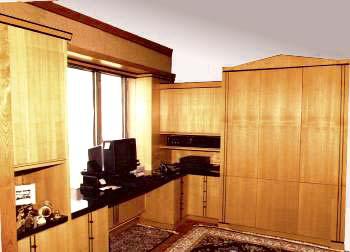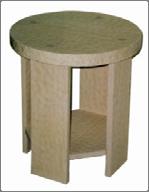Bleaching Wood
Bleaching is a chemical process that lightens the color of wood. Wood can be darkened by several processes, ranging from the natural to the accidental. What process caused the wood to darken would determine which of the three bleaching processes you would use to lighten it.
Before I go any further, I want to state that all the bleaches are very strong and caustic chemicals. Be sure that you wear rubber gloves, goggles, and an approved respirator. Always provide proper ventilation and have some clean water at hand in case you get splashed and need to quickly rinse yourself. Read and follow all manufacturers warning labels. Most of these products have the capacity to burn you even after they are dry, so beware. Wear a dust mask when working with dry chemicals or sanding bleached wood. Bleaches work only on bare wood, so if the wood is finished, it must be stripped before bleaching.
Sometimes you will have to experiment with different bleaching processes to find the one that will work for your particular situation. Make sure that any previous application of bleach has been properly neutralized and is thoroughly dry before attempting to apply a different bleach product. Failing to do so could result in a harmful chemical reaction. Only use plastic containers – never metal – to hold the bleach. When working with any of these products, always err on the side of caution and safety.

Chlorine Bleach
Chlorine bleach is the best choice for removing dye stains, and some organic stains such as grape juice and tea stains. You can use a household type of chlorine bleach, such as Clorox, but you will probably find that it takes several applications. You can also use swimming pool chlorine, calcium hypochlorite, which is much stronger. Add the calcium hypochlorite to water until the solution saturates and no more will dissolve.
Make only enough to use in one day. Even if you are only trying to remove a spot, wipe the solution over the entire surface so that the final color is a little more uniform. Once bleaching is complete, rinse the surface several times with distilled water. Neutralize the surface using a solution of one quart of water mixed with two tablespoons of baking soda.
Oxalic Acid
Oxalic acid is the best choice for removing black iron or water stains. Ordinary household tap water contains a small amount of iron. The iron in the water reacts with the tannic acid in woods like oak and mahogany. Often these stains are caused by the wood being exposed to wet glasses or spills. Some black inks are iron-based and oxalic acid will also remove them. Nothing will remove carbon-based India ink.
Make a saturated solution of oxalic acid and warm water and apply to the entire surface. Some stains may require several applications, allowing each application to dry overnight before re-applying the bleach. Once the stain is removed, always flood the surface several times with distilled water to remove any excess acid crystals. Distilled water contains no iron. Neutralize the surface using a solution of one quart water mixed with two tablespoons of baking soda.
Two-Part Wood Bleach
For certain effects, you need to use the two-part bleaches. Part A is Sodium Hydroxide which opens up the wood’s pores and then reacts with the Hydrogen Peroxide in Part B.
Sometimes the background color of the wood will not let you get to the color that you want. It might be a situation that requires a very light color or even a dark color that is beyond the range of what a dye can shift your background color to, for instance, a cold brown on red oak. It might even be a situation where the background color has to be a very even, non-descript color. This is the perfect situation to use wood bleach. Bleaching is not a fun job by any means, but it does allow you to obtain an effect that cannot be reproduced in any other manner. Bleaching will lighten most woods to some degree, but you get the best results on oak, walnut, and mahogany. These are also open-pore woods, so you can apply paste wood fillers or glazes to the pores to get some very high contrast colors such as the cereuses.
Start by giving your wood a quick rough sand with 100-grit paper. This gives the wood a uniform texture and gets rid of any burnished areas that might resist taking the bleach. Apply Part A liberally to the wood (it is important to keep it wet). The wood will turn a dark brown. Next, apply Part B with a liberal coat – do not play with it, just get it on quickly. Move the bleach around and keep it wet. After a few minutes, you may want to apply a little more Part B. Let the bleach dry. The next day, wash the bleached surfaces with water and a 15% vinegar solution to neutralize the bleach. Let dry for 1-3 days before finish sanding.

Bleaching Things to Watch Out For
- If bleach splashes on something, the spot will be there forever. Even if you bleach the object, it will always be lighter than the surrounding surface, so bleach both sides of a door at the same time. On vertical surfaces, start from the bottom and work up to avoid streaks in the color.
- Tight pore woods like mahogany are prone to pin-holing after bleaching. Make your first coat of finish a washcoat and you should see a reduction in the pin-holes. Try different percent reductions in the washcoats until you find the one that works best for your particular situation.
- Always bleach a few extra pieces of wood so you have materials to experiment on and make samples with.
- Keep unbleached items out of the way until you are ready to bleach them.
- Use separate rags for Part A and Part B to avoid diluting the solutions. Avoid letting the rags come in contact with each other.
- When sanding, wear dust masks and rubber gloves. Any moisture (like sweat or your moist breath) will reactivate the bleach and cause a burn – even though it was neutralized.
- Watch your sanding so that you do not sand through the color.
- Make sure the wood is totally dry before proceeding to your sanding steps.
- The Part B is an oxidizer and will cause steel to rust. This includes nails, screws, or tools that happen to be close by.
- Safety precautions are a must. Good ventilation, GOGGLES- not glasses, aprons, and gloves. Have a bucket of the vinegar solution near by in case you get splashed; it takes a while to notice the pain and an even longer to make it stop. Have sawdust available to sprinkle on the floor if it gets slippery.
- Always wash your hands before going to the bathroom. No explanation needed.
- Soak your rags in clean water and then dispose them outside the building.
- Bleaching is smelly, dangerous stuff. Plan things out, make safety first and be sure you charge for your efforts and risks.
